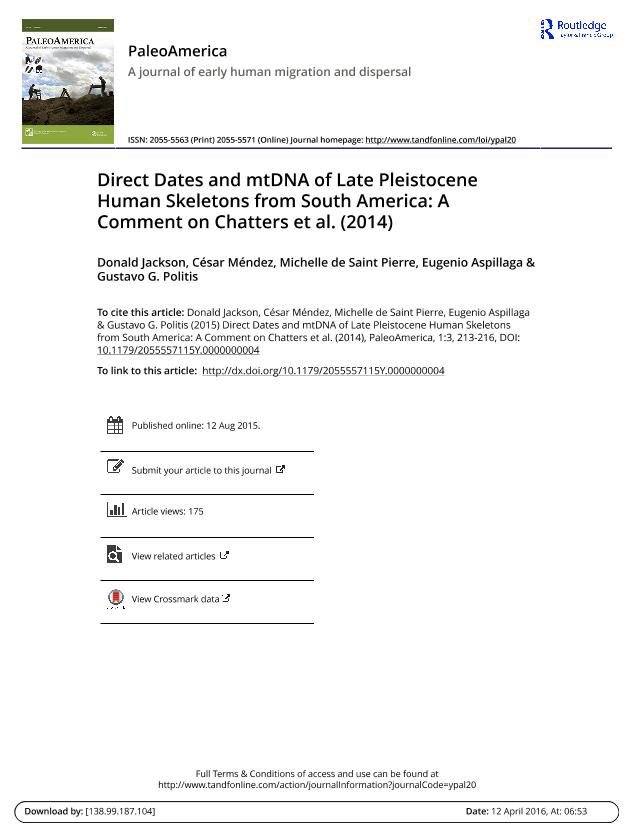Artículo
Direct Dates and mtDNA of Late Pleistocene Human Skeletons from South America: A Comment on Chatters et al. (2014)
Jackson, Donald; Mendez, Cesar; de Saint Pierre, Michelle; Aspillaga, Eugenio; Politis, Gustavo Gabriel

Fecha de publicación:
08/2015
Editorial:
Routledge
Revista:
PaleoAmerica
ISSN:
2055-5571
Idioma:
Inglés
Tipo de recurso:
Artículo publicado
Clasificación temática:
Resumen
In a recent paper in the journal Science (2014, Vol.344, pp. 750?754), J. Chatters et al. present a new early human skeleton from the Yucatan, Mexico, considering it in the context of eight other early Paleoamerican individuals all from North America that previously yielded ancient genetic evidence and/or direct radiocarbon ages. Despite including the archaeological site of Monte Verde II, Chile, in their discussion, we were alarmed that the authors otherwise ignored the South American record, presenting a map with the southern continent being devoid of PaleoAmerican human remains. We felt it important to remind our colleagues that South America has produced numerous directly dated human skeletal remains that are as old as the ones cited by Chatters et al. for North America, and that several of these have actually yielded mitochondrial (mt) DNA. Significant implications can be derived from this radiocarbon, bioanthropological, and mtDNA dataset, especially considering the antiquity of the earliest human populations and process of peopling of the New World. Undoubtedly, the remains recovered from Hoyo Negro (HN5/48) cave by Chatters et al. constitute a significant archaeological discovery, considering how elusive and incomplete early skeletal material for the Americas is. The remains were recovered from an ancient cavern that was available to humans before the end of the Pleistocene, before Postglacial sealevel rise. Fresh bone fractures on the individual suggest a death due to a fall when the cavern was filled with shallow water. Consequently, the Hoyo Negro human skeleton represents a bone assemblage deposited naturally, in a palimpsest with remains of other species that accumulated at different times. As the authors discuss, radiocarbon and uranium?thorium dates on human teeth and bones, extinct faunal remains, and calcite speleothems together indicate the human remains were deposited by 12,000?13,000 cal yr BP. However, the absence of associated cultural remains limits the interpretive value of this significant discovery.Other skeletal remains have been recovered in a nearby flooded cave system known as Cenote Naharon, by a team led by A. González. Among them is a human femur radiocarbon dated to about 13,500 cal yr BP according to its amino-acid fraction, but this date has yet to be replicated, underscoring the problematic nature of dating organic material in these submerged cavern systems. In South America, there are now 23 direct dates on 21 individuals from 13 sites that have yielded ages older than 10,000 cal yr BP (Table 1, Figure 1; for references see ?Suggested Reading? after the editorial, as well as the report by L. Menendez et al. in this issue of PaleoAmerica). Among them, four sites have produced direct dates older than 12,000 cal yr BP: Los Rieles in the semiarid north of Chile, Arroyo de Frías in the Pampean region of Argentina, Gruta de Candonga in the Sierra de Córdoba of Argentina, and Toca do Gordo do Garrincho in northeastern Brazil.
Palabras clave:
LATE PLEISTOCENE
,
HUMAN SKELETONS
,
SOUTH AMERICA
Archivos asociados
Licencia
Identificadores
Colecciones
Articulos(INCUAPA)
Articulos de INVESTIGACIONES ARQUEOLOGICAS Y PALEONTOLOGICAS DEL CUATERNARIO PAMPEANO
Articulos de INVESTIGACIONES ARQUEOLOGICAS Y PALEONTOLOGICAS DEL CUATERNARIO PAMPEANO
Citación
Jackson, Donald; Mendez, Cesar; de Saint Pierre, Michelle; Aspillaga, Eugenio; Politis, Gustavo Gabriel; Direct Dates and mtDNA of Late Pleistocene Human Skeletons from South America: A Comment on Chatters et al. (2014); Routledge; PaleoAmerica; 1; 3; 8-2015; 213-216
Compartir
Altmétricas



